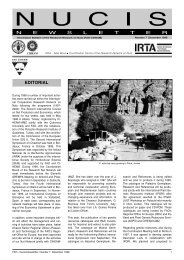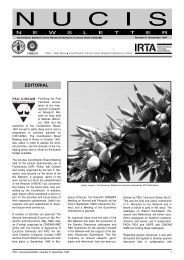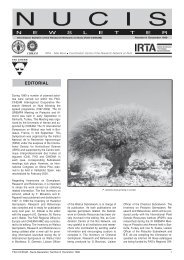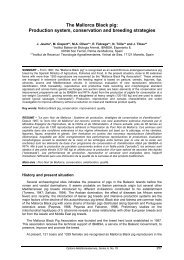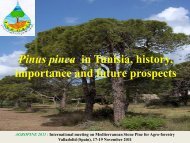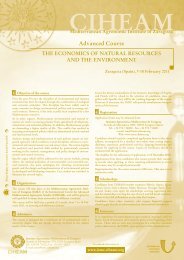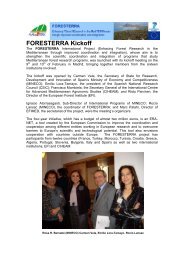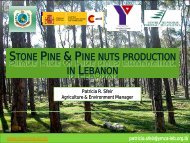NUCIS number 12. September 2004. 52 pages (full ... - IAMZ - ciheam
NUCIS number 12. September 2004. 52 pages (full ... - IAMZ - ciheam
NUCIS number 12. September 2004. 52 pages (full ... - IAMZ - ciheam
- No tags were found...
You also want an ePaper? Increase the reach of your titles
YUMPU automatically turns print PDFs into web optimized ePapers that Google loves.
Early blooming selections: Frost damageon small fruits ranged from 20% (G-6-39) to 77% (H-3-39) and produced a heavyreduction of fruit set, which was practicallynil in some (G-1-38 and H-3-37) andeconomically insufficient in others (G-2-23, G-2-7, G-5-18, G-6-24, and H-3-39).These could be due to the fact that theseselections had a young developing fruit,which is considered the most vulnerablestage to frost (Proebsting and Mills,1978b).Figure 1: Blooming time and fruit set of the studied selectionsIn addition, some selections showed anintermediate fruit set, although not commerciallyacceptable (G-6-39, I-1-95, andI-2-12), and selection G-1-58 showedvery high fruit set (33.5%), of a commerciallevel (Kester and Griggs, 1959). Thesedifferences, observed in selectionsthat were at the same phenological stage,could be due to a differential resistance ofthese selections to frost damage. Thesame observation was reported for otheralmond cultivars previously studied (Felipe,1988), as spring frost damage on reproductiveorgans depends mainly on thecultivar (Proebsting and Mills, 1978a) andon the intensity and duration of the lowtemperature (Mazur, 1969). In fact, differencesin yield losses have been observedamong almond cultivars at differentcritical low temperatures (Felipe, 1988).This suggests that selection G-1-58 hassuffered lighter losses than the other selectionsof this group with a temperatureof –2.5°C.A high negative correlation was observedbetween the percentage of fruit damageand fruit set (-0.65), showing how theamount of damaged fruits significantly reducesfruit set. There was also a high negativecorrelation between the percentageof damaged fruits and bud density (-0.63), showing that the effect of springfrosts is higher in selections with a lowerbud density. Moreover, a significant positivecorrelation was found between buddensity and fruit set (0.42), thus, fruit setof selections with a medium to high buddensity is higher than that of selectionswith a low bud density (Fig 2). This couldbe due to the fact that a high potential toproduce bud flowers may compensate thespring frost damages, and, together witha good frost resistance, as in the case ofselection G-1-58, could maintain the fruitset at a commercially acceptable level.Late blooming selections: flower andbud frost damage ranged from 2% (G-2-2) to 47% (G-3-5), generally lower thanthe fruit damage on selections of the earlyflowering group, confirming that frostdamage is highly dependent on the stageof bud development, as selections of thelate flowering group (Fig 1) were in theearly blooming stages, C, D and a few E(Felipe, 1977) when the frost happened.Also, the flower hardness of each selection(genotype) reflects the differencesamong selections at the same phenologicalstage (Westwood, 1993).In general, fruit set decreased when theamount of damaged flowers increased(Figure 3), which explains the significantnegative correlation between fruit set andpercentage of damaged flowers (-0.37).In addition, in spite of the high percentageof damaged flowers, selection G-3-5shows a medium fruit set (Figure 3). Thiscould be due to the high bud density ofthis selection, which has compensatedthe loss of flowers and maintained a mediumfruit set.CONCLUSIONIn general, the amount of damages causedby frost in selections at the beginningof bloom (late flowering group) wereslight in comparison to the damages causedin early blooming selections (earlyflowering group), confirming that frost damageis highly dependent on the phenologicalstage of the bud/flower/fruit, theearly developing fruit being the most susceptiblestage (Proebsting and Mills,1978b). Furthermore, differences observedamong selections for the amount offlower and fruit losses show different frosthardness for each selection. Consequently,only tolerant or resistant genotypes(cultivars or selections) can produce acrop when frost takes place at or laterthan blooming time.In some cases frost produced the completeloss of the crop, and in others animportant reduction of fruit set and, consequently,of yield. Moreover, selectionshaving a high bud density gave a fruit setfrom medium to acceptable. Hence, ahigh bud density seems to compensatespring frost damages.These data were not enough to explainthe effect of spring frost damage on fruitset, because fruit set in almond dependson several factors, including other weatherconditions (such as rain), insect activityamong inter-compatible and overlappingblooming cultivars or the ability fornatural autogamy in self-compatible cultivars(Socias i Company and Felipe,1992). However, a wide variability of responsesto frost were observed in theseselections, showing that even with thisfrost some genotypes can reach a 25-40% fruit set, considered as the economicallyacceptable threshold for a commercialcrop (Kester and Griggs, 1959). Consequently,selection for frost resistancecan be efficiently undertaken to obtain6 FAO-CIHEAM - Nucis-Newsletter, Number 12 <strong>September</strong> 2004



